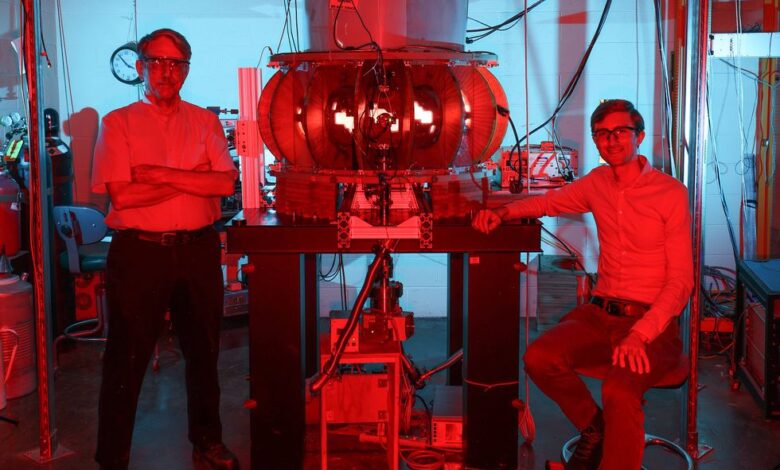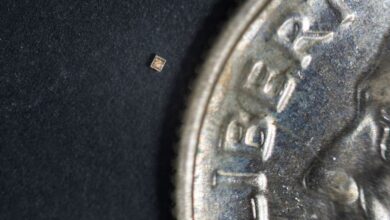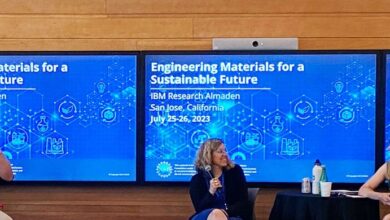Nuclear Fusion’s New Idea: An Off-the-Shelf Stellarator

For a machine that’s designed to replicate a star, the world’s newest stellarator is a surprisingly humble-looking apparatus. The kitchen-table-size contraption sits atop stacks of bricks in a cinder-block room at the Princeton Plasma Physics Laboratory (PPPL) in Princeton, N.J., its parts hand-labeled in marker.
The PPPL team invented this nuclear-fusion reactor, completed last year, using mainly off-the-shelf components. Its core is a glass vacuum chamber surrounded by a 3D-printed nylon shell that anchors 9,920 meticulously placed permanent rare-earth magnets. Sixteen copper-coil electromagnets resembling giant slices of pineapple wrap around the shell crosswise.
The arrangement of magnets forms the defining feature of a stellarator: an entirely external magnetic field that directs charged particles along a spiral path to confine a superheated plasma. Within this enigmatic fourth state of matter, atoms that have been stripped of their electrons collide, their nuclei fusing and releasing energy in the same process that powers the sun and other stars. Researchers hope to capture this energy and use it to produce clean, zero-carbon electricity.
PPPL’s new reactor is the first stellarator built at this government lab in 50 years. It’s also the world’s first stellarator to employ permanent magnets, rather than just electromagnets, to coax plasma into an optimal three-dimensional shape. Costing only US $640,000 and built in less than a year, the device stands in contrast to prominent stellarators like Germany’s
Wendelstein 7-X, a massive, tentacled machine that took $1.1 billion and more than 20 years to construct.
Sixteen copper-coil electromagnets resembling giant slices of pineapple wrap around the stellarator’s shell. Jayme Thornton
PPPL researchers say their simpler machine demonstrates a way to build stellarators far more cheaply and quickly, allowing researchers to easily test new concepts for future fusion power plants. The team’s use of permanent magnets may not be the ticket to producing commercial-scale energy, but PPPL’s accelerated design-build-test strategy could crank out new insights on plasma behavior that could push the field forward more rapidly.
Indeed, the team’s work has already spurred the formation of two stellarator startups that are testing their own PPPL-inspired designs, which their founders hope will lead to breakthroughs in the quest for fusion energy.
Are Stellarators the Future of Nuclear Fusion?
The pursuit of energy production through nuclear fusion is considered by many to be the holy grail of clean energy. And it’s become increasingly important as a rapidly warming climate and soaring electricity demand have made the need for stable, carbon-free power ever more acute. Fusion offers the prospect of a nearly limitless source of energy with no greenhouse gas emissions. And unlike conventional nuclear fission, fusion comes with no risk of meltdowns or weaponization, and no long-lived nuclear waste.
Fusion reactions have powered the sun since it formed an estimated 4.6 billion years ago, but they have never served to produce usable energy on Earth, despite
decades of effort. The problem isn’t whether fusion can work. Physics laboratories and even a few individuals have successfully fused the nuclei of hydrogen, liberating energy. But to produce more power than is consumed in the process, simply fusing atoms isn’t enough.
Fueled by free pizza, grad students meticulously placed 9,920 permanent rare-earth magnets inside the stellarator’s 3D-printed nylon shell. Jayme Thornton
The past few years have brought eye-opening advances from government-funded fusion programs such as PPPL and the
Joint European Torus, as well as private companies. Enabled by gains in high-speed computing, artificial intelligence, and materials science, nuclear physicists and engineers are toppling longstanding technical hurdles. And stellarators, a once-overlooked approach, are back in the spotlight.
“Stellarators are one of the most active research areas now, with new papers coming out just about every week,” says
Scott Hsu, the U.S. Department of Energy’s lead fusion coordinator. “We’re seeing new optimized designs that we weren’t capable of coming up with even 10 years ago. The other half of the story that’s just as exciting is that new superconductor technology and advanced manufacturing capabilities are making it more possible to actually realize these exquisite designs.”
Why Is Plasma Containment Important in Fusion Energy?
For atomic nuclei to fuse, the nuclei must overcome their natural electrostatic repulsion. Extremely high temperatures—in the millions of degrees—will get the particles moving fast enough to collide and fuse. Deuterium and tritium, isotopes of hydrogen with, respectively, one and two neutrons in their nuclei, are the preferred fuels for fusion because their nuclei can overcome the repulsive forces more easily than those of heavier atoms.
Heating these isotopes to the required temperatures strips electrons from the atomic nuclei, forming a plasma: a maelstrom of positively charged nuclei and negatively charged electrons. The trick is keeping that searingly hot plasma contained so that some of the nuclei fuse.
Currently, there are two main approaches to containing plasma.
Inertial confinement uses high-energy lasers or ion beams to rapidly compress and heat a small fuel pellet. Magnetic confinement uses powerful magnetic fields to guide the charged particles along magnetic-field lines, preventing these particles from drifting outward.
Many
magnetic-confinement designs—including the $24.5 billion ITER reactor under construction since 2010 in the hills of southern France—use an internal current flowing through the plasma to help to shape the magnetic field. But this current can create instabilities, and even small instabilities in the plasma can cause it to escape confinement, leading to energy losses and potential damage to the hardware.
Stellarators like PPPL’s are a type of magnetic confinement, with a twist.
How the Stellarator Was Born
Located at the end of Stellarator Road and a roughly 5-kilometer drive from
Princeton University’s leafy campus, PPPL is one of 17 U.S. Department of Energy labs, and it employs about 800 scientists, engineers, and other workers. Hanging in PPPL’s lobby is a black-and-white photo of the lab’s founder, physicist Lyman Spitzer, smiling as he shows off the fanciful-looking apparatus he invented and dubbed a stellarator, or “star generator.”
According to the lab’s lore, Spitzer came up with the idea while riding a ski lift at Aspen Mountain in 1951. Enrico Fermi had observed that a simple toroidal, or doughnut-shaped, magnetic-confinement system wouldn’t be sufficient to contain plasma for nuclear fusion because the charged particles would drift outward and escape confinement.
“This technology is designed to be a stepping stone toward a fusion power plant.”
Spitzer determined that a figure-eight design with external magnets could create helical magnetic-field lines that would spiral around the plasma and more efficiently control and contain the energetic particles. That configuration, Spitzer reasoned, would be efficient enough that it wouldn’t require large currents running through the plasma, thus reducing the risk of instabilities and allowing for steady-state operation.
“In many ways, Spitzer’s brilliant idea was the perfect answer” to the problems of plasma confinement, says Steven Cowley, PPPL’s director since 2018. “The stellarator offered something that other approaches to fusion energy couldn’t: a stable plasma field that can sustain itself without any internal current.”
Spitzer’s stellarator quickly captured the imagination of midcentury nuclear physicists and engineers. But the invention was ahead of its time.
Tokamaks vs. Stellarators
The stellarator’s lack of toroidal symmetry made it challenging to build. The external magnetic coils needed to be precisely engineered into complex, three-dimensional shapes to generate the twisted magnetic fields required for stable plasma confinement. In the 1950s, researchers lacked the high-performance computers needed to design optimal three-dimensional magnetic fields and the engineering capability to build machines with the requisite precision.
Meanwhile, physicists in the Soviet Union were testing a new configuration for magnetically confined nuclear fusion: a doughnut-shaped device called a tokamak—a Russian acronym that stands for “toroidal chamber with magnetic coils.” Tokamaks bend an externally applied magnetic field into a helical field inside by sending a current through the plasma. They seemed to be able to produce plasmas that were hotter and denser than those produced by stellarators. And compared with the outrageously complex geometry of stellarators, the symmetry of the tokamaks’ toroidal shape made them much easier to build.
Lyman Spitzer in the early 1950s built the first stellarator, using a figure-eight design and external magnets. PPPL
Following the lead of other nations’ fusion programs, the DOE shifted most of its fusion resources to tokamak research. PPPL converted Spitzer’s Model C stellarator into a tokamak
in 1969.
Since then, tokamaks have dominated fusion-energy research. But by the late 1980s, the limitations of the approach were becoming more apparent. In particular, the currents that run through a tokamak’s plasma to stabilize and heat it are themselves a source of instabilities as the currents get stronger.
To force the restive plasma into submission, the geometrically simple tokamaks need additional features that increase their complexity and cost. Advanced tokamaks—there are about 60 currently operating—have systems for heating and controlling the plasma and massive arrays of magnets to create the confining magnetic fields. They also have cryogenics to cool the magnets to superconducting temperatures a few meters away from a 150 million °C plasma.
Tokamaks thus far have produced energy only in short pulses. “After 70 years, nobody really has even a good concept for how to make a steady-state tokamak,” notes
Michael Zarnstorff, a staff research physicist at PPPL. “The longest pulse so far is just a few minutes. When we talk to electric utilities, that’s not actually what they want to buy.”
Computational Power Revives the Stellarator
With tokamaks gobbling up most of the world’s public fusion-energy funds, stellarator research lay mostly dormant until the 1980s. Then, some theorists started to put increasingly powerful computers to work to help them optimize the placement of magnetic coils to more precisely shape the magnetic fields.
The effort got a boost in 1981, when then-PPPL physicist
Allen Boozer invented a coordinate system—known in the physics community as Boozer coordinates—that helps scientists understand how different configurations of magnets affect magnetic fields and plasma confinement. They can then design better devices to maintain stable plasma conditions for fusion. Boozer coordinates can also reveal hidden symmetries in the three-dimensional magnetic-field structure, which aren’t easily visible in other coordinate systems. These symmetries can significantly improve plasma confinement, reduce energy losses, and make the fusion process more efficient.
“We’re seeing new optimized designs we weren’t capable of coming up with 10 years ago.”
“The accelerating computational power finally allowed researchers to challenge the so-called fatal flaw of stellarators: the lack of toroidal symmetry,” says Boozer, who is now a professor of applied physics at Columbia University.
The new insights gave rise to stellarator designs that were far more complex than anything Spitzer could have imagined [see sidebar, “Trailblazing Stellarators”]. Japan’s
Large Helical Device came online in 1998 after eight years of construction. The University of Wisconsin’s Helically Symmetric Experiment, whose magnetic-field coils featured an innovative quasi-helical symmetry, took nine years to build and began operation in 1999. And Germany’s Wendelstein 7-X—the largest and most advanced stellarator ever built—produced its first plasma in 2015, after more than 20 years of design and construction.
Experiment Failure Leads to New Stellarator Design
In the late 1990s, PPPL physicists and engineers began designing their own version, called the National Compact Stellarator Experiment (NCSX). Envisioned as the world’s most advanced stellarator, it employed a new magnetic-confinement concept called quasi-axisymmetry—a compromise that mimics the symmetry of a tokamak while retaining the stability and confinement benefits of a stellarator by using only externally generated magnetic fields.
“We tapped into every supercomputer we could find,” says Zarnstorff, who led the NCSX design team, “performing simulations of hundreds of thousands of plasma configurations to optimize the physics properties.”
Three Ways to Send Atoms on a Fantastical Helical Ride
But the design was, like Spitzer’s original invention, ahead of its time. Engineers struggled to meet the precise tolerances, which allowed for a maximum variation from assigned dimensions of only 1.5 millimeters across the entire device. In 2008, with the project tens of millions of dollars over budget and years behind schedule, NCSX was canceled. “That was a very sad day around here,” says Zarnstorff. “We got to build all the pieces, but we never got to put it together.”
Now, a segment of the NCSX vacuum vessel—a contorted hunk made from the superalloy Inconel—towers over a lonely corner of the C-Site Stellarator Building on PPPL’s campus. But if its presence is a reminder of failure, it is equally a reminder of the lessons learned from the $70 million project.
For Zarnstorff, the most important insights came from the engineering postmortem. Engineers concluded that, even if they had managed to successfully build and operate NCSX, it was doomed by the lack of a viable way to take the machine apart for repairs or reconfigure the magnets and other components.
With the experience gained from NCSX and PPPL physicists’ ongoing collaborations with the costly, delay-plagued Wendelstein 7-X program, the path forward became clearer. “Whatever we built next, we knew we needed to make it less expensively and more reliably,” says Zarnstorff. “And we knew we needed to build it in a way that would allow us to take the thing apart.”
A Testbed for Fusion Energy
In 2014, Zarnstorff began thinking about building a first-of-its-kind stellarator that would use permanent magnets, rather than electromagnets, to create its helical field, while retaining electromagnets to shape the toroidal field. (Electromagnets generate a magnetic field when an electric current flows through them and can be turned on or off, whereas permanent magnets produce a constant magnetic field without needing an external power source.)
Even the strongest permanent magnets wouldn’t be capable of confining plasma robustly enough to produce commercial-scale fusion power. But they could be used to create a lower-cost experimental device that would be easier to build and maintain. And that, crucially, would allow researchers to easily adjust and test magnetic fields that could inform the path to a power-producing device.
PPPL dubbed the device Muse. “Muse was envisioned as a testbed for innovative magnetic configurations and improving theoretical models,” says PPPL research physicist Kenneth Hammond, who is now leading the project. “Rather than immediate commercial application, it’s more focused on exploring fundamental aspects of stellarator design and plasma behavior.”
The Muse team designed the reactor with two independent sets of magnets. To coax charged particles into a corkscrew-like trajectory, small permanent neodymium magnets are arranged in pairs and mounted to a dozen 3D-printed panels surrounding the glass vacuum chamber, which was custom-made by glass blowers. Adjacent rows of magnets are oriented in opposite directions, twisting the magnetic-field lines at the outside edges.
Outside the shell, 16 electromagnets composed of circular copper coils generate the toroidal part of the magnetic field. These very coils were mass-produced by PPPL in the 1960s, and they have been a workhorse for rapid prototyping in numerous physics laboratories ever since.
“In terms of its ability to confine particles, Muse is two orders of magnitude better than any stellarator previously built,” says Hammond. “And because it’s the first working stellarator with quasi-axisymmetry, we will be able to test some of the theories we never got to test on NCSX.”
The neodymium magnets are a little bigger than a button magnet that might be used to hold a photo to a refrigerator door. Despite their compactness, they pack a remarkable punch. During my visit to PPPL, I turned a pair of magnets in my hands, alternating their polarities, and found it difficult to push them together and pull them apart.
Graduate students did the meticulous work of placing and securing the magnets. “This is a machine built on pizza, basically,” says Cowley, PPPL’s director. “You can get a lot out of graduate students if you give them pizza. There may have been beer too, but if there was, I don’t want to know about it.”
The Muse project was financed by internal R&D funds and used mostly off-the-shelf components. “Having done it this way, I would never choose to do it any other way,” Zarnstorff says.
Stellarex and Thea Energy Advance Stellarator Concepts
Now that Muse has demonstrated that stellarators can be made quickly, cheaply, and highly accurately, companies founded by current and former PPPL researchers are moving forward with Muse-inspired designs.
Zarnstorff recently cofounded a company called Stellarex. He says he sees stellarators as the best path to fusion energy, but he hasn’t landed on a magnet configuration for future machines. “It may be a combination of permanent and superconducting electromagnets, but we’re not religious about any one particular approach; we’re leaving those options open for now.” The company has secured some DOE research grants and is now focused on raising money from investors.
Thea Energy, a startup led by David Gates, who until recently was the head of stellarator physics at PPPL, is further along with its power-plant concept, also inspired by Muse. Like Muse, Thea focuses on simplified manufacture and maintenance. Unlike Muse, the Thea concept uses planar (flat) electromagnetic coils built of high-temperature superconductors.
Thea Energy
“The idea is to use hundreds of small electromagnets that behave a lot like permanent magnets, with each creating a dipole field that can be switched on and off,” says Gates. “By using so many individually actuated coils, we can get a high degree of control, and we can dynamically adjust and shape the magnetic fields in real time to optimize performance and adapt to different conditions.”
The company has raised more than $23 million and is designing and building a half-scale prototype of its initial project, which it calls Eos, in Kearny, N.J. “At first, it will be focused on producing neutrons and isotopes like tritium,” says Gates. “The technology is designed to be a stepping stone toward a fusion power plant called Helios, with the potential for near-term commercialization.”
Stellarator Startup Leverages Exascale Computing
Of all the private stellarator startups, Type One Energy is the most well funded, having raised $82.5 million from investors that include Bill Gates’s Breakthrough Energy Ventures. Type One’s leaders contributed to the design and construction of both the University of Wisconsin’s Helically Symmetric Experiment and Germany’s Wendelstein 7-X stellarators.
The Type One stellarator design utilizes a highly optimized magnetic-field configuration designed to improve plasma confinement. Optimization can relax the stringent construction tolerances typically required for stellarators, making them easier and more cost-effective to engineer and build.
Type One’s design, like that of Thea Energy’s Eos, makes use of high-temperature superconducting magnets, which provide higher magnetic strength, require less cooling power, and could lower costs and allow for a more compact and efficient reactor. The magnets, licensed from MIT, were designed for a tokamak, but Type One is modifying the coil structure to accommodate the intricate twists and turns of a stellarator.
In a sign that stellarator research may be moving from mainly scientific experiments into the race to field the first commercially viable reactor, Type One recently announced that it will build “the world’s most advanced stellarator” at the Bull Run Fossil Plant in Clinton, Tenn. To construct what it’s calling Infinity One—expected to be operational by early 2029—Type One is teaming up with the Tennessee Valley Authority and the DOE’s Oak Ridge National Laboratory.
“As an engineering testbed, Infinity One will not be producing energy,” says Type One CEO Chris Mowry. “Instead, it will allow us to retire any remaining risks and sign off on key features of the fusion pilot plant we are currently designing. Once the design validations are complete, we will begin the construction of our pilot plant to put fusion electrons on the grid.”
To help optimize the magnetic-field configuration, Mowry and his colleagues are utilizing Summit, one of Oak Ridge’s state-of-the-art exascale supercomputers. Summit is capable of performing more than 200 million times as many operations per second as the supercomputers of the early 1980s, when Wendelstein 7-X was first conceptualized.
AI Boosts Fusion Reactor Efficiency
Advances in computational power are already leading to faster design cycles, greater plasma stability, and better reactor designs. Ten years ago, an analysis of a million different configurations would have taken months; now a researcher can get answers in hours.
And yet, there are an infinite number of ways to make any particular magnetic field. “To find our way to an optimum fusion machine, we may need to consider something like 10 billion configurations,” says PPPL’s Cowley. “If it takes months to make that analysis, even with high-performance computing, that’s still not a route to fusion in a short amount of time.”
In the hope of shortcutting some of those steps, PPPL and other labs are investing in artificial intelligence and using surrogate models that can search and then rapidly home in on promising solutions. “Then, you start running progressively more precise models, which bring you closer and closer to the answer,” Cowley says. “That way we can converge on something in a useful amount of time.”
But the biggest remaining hurdles for stellarators, and magnetic-confinement fusion in general, involve engineering challenges rather than physics challenges, say Cowley and other fusion experts. These include developing materials that can withstand extreme conditions, managing heat and power efficiently, advancing magnet technology, and integrating all these components into a functional and scalable reactor.
Over the past half decade, the vibe at PPPL has grown increasingly optimistic, as new buildings go up and new researchers arrive on Stellarator Road to become part of what may be the grandest scientific challenge of the 21st century: enabling a world powered by safe, plentiful, carbon-free energy.
PPPL recently broke ground on a new $110 million office and laboratory building that will house theoretical and computational scientists and support the work in artificial intelligence and high-performance computing that is increasingly propelling the quest for fusion. The new facility will also provide space for research supporting PPPL’s expanded mission into microelectronics, quantum sensors and devices, and sustainability sciences.
PPPL researchers’ quest will take a lot of hard work and, probably, a fair bit of luck. Stellarator Road may be only a mile long, but the path to success in fusion energy will certainly stretch considerably farther.
Trailblazing Stellarators
In contrast to Muse’s relatively simple, low-cost approach, these pioneering stellarators are some of the most technically demanding machines ever built, with intricate electromagnetic coil systems and complex geometries that require precise engineering. The projects have provided valuable insights into plasma confinement, magnetic-field optimization, and the potential for steady-state operation, and moved the scientific community closer to achieving practical and sustainable fusion energy.
Large Helical Device (LHD)
Helically Symmetric Experiment (HSX)
Wendelstein 7-X (W7-X)
IEEE Spectrum




